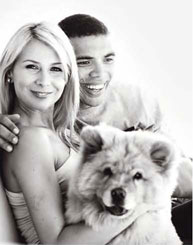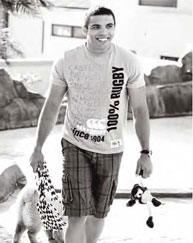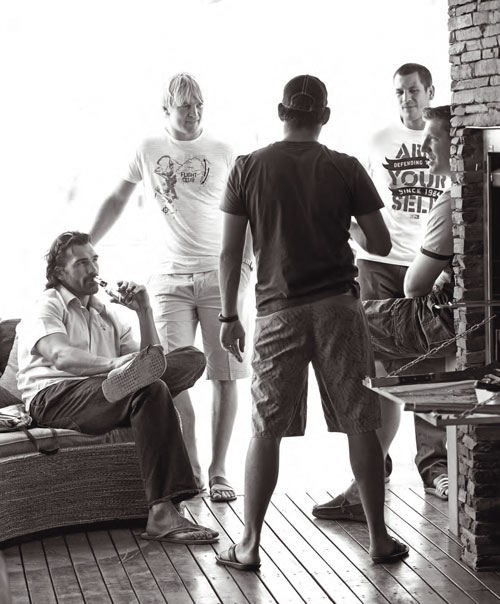
BLOOD BROTHERS: Victor Matfield, Dewald Potgieter, Fourie du Preez, Pierre Spies and Bakkies Botha doing what every fan does, analysing the big game over beers and a braai.
PANCAKES:
¼ C (60 ml) cake flour
4 extra-large eggs, beaten
¼ C (60 ml) sugar
2 T (30 ml) full-cream milk
4 t (20 ml) ghee
1 t (5 ml) vanilla essence
2 t (10 ml) baking powder
FILLING:
1 C (250 ml) fresh cream, whipped
50 g dark or milk chocolate, grated
50 g slivered almonds, toasted (optional)
RICKY’S METHOD:
‘Place the flour into a bowl, make a hollow in the centre and add the rest of the pancake ingredients, except for the baking powder. Beat well and set aside, covered, for a few hours. Add the baking powder just before cooking, and beat in well. Heat a heavy 15 cm skillet with a flat base. Grease the pan with 1 T (15 ml) ghee. Spoon in 2 T (30 ml) of batter at a time to make thin pancakes or ghawla. Turn over and cook until both sides are lightly golden.
‘Spread each ghawla with whipped cream. On alternate layers of ghawla sprinkle grated chocolate and slivered almonds to make a tower of pancakes (seven layers should be sufficient, but add more if you prefer!).’
SERVES 2–4 (MAKES ABOUT 10 PANCAKES)
RICKY JANUARIE: Springbok scrumhalf 2005–2011, and 2007 Rugby World Cup winner

2 C (500 ml) cake flour
2 t (10 ml) baking powder
½ t (2.5 ml) salt
2 T (30 ml) sugar
125 g butter, cut into small blocks
3 extra-large eggs, separated
2 T (30 ml) cold water
smooth apricot jam
¾ C (180 ml) desiccated coconut
¾ C (180 ml) castor sugar
ADI’S METHOD:
‘Sift the flour, baking powder, salt and sugar together. Rub in the butter with your fingertips. Mix the egg yolks and water together and add to the dry ingredients. Mix together to form a pastry. Allow to rest in the fridge for 30 minutes.
‘Preheat the oven to 180 °C. Roll out the pastry and cut into circles to fit into patty pans. Cut the circles slightly larger to allow for shrinkage. Place a dot of apricot jam onto each pastry circle. Whip the egg whites only until foamy. Do not overwhip! Mix in the coconut and castor sugar. Spoon the coconut mixture on top of the jam and bake for 10–15 minutes.’
MAKES ABOUT 36
ADI JACOBS: Springbok centre 2001–2010, and member of the team that won the series against the 2009 British & Irish Lions

500 g butter, softened
2 C (500 ml) castor sugar
1 t (5 ml) vanilla essence
¾ C (180 ml) canola oil
2 extra-large eggs
8 C (8 x 250 ml) cake flour
1 t (5 ml) baking powder
pinch salt
CASSIEM’S METHOD:
‘Preheat the oven to 180 °C. Line 2 baking trays with baking paper. Cream the butter and sugar together and add the vanilla. Slowly add the oil and beat in well. Add the eggs, one at a time, and beat well after each addition. Sift the flour, baking powder and salt together. Add to the butter mixture and fold in. Shape the dough into small balls, place on the baking trays and flatten with a fork. Bake for 10–15 minutes or until light brown. For variation, add walnuts, pecan nuts, dates or cherries.’
MAKES ABOUT 100 BISCUITS
CASSIEM JABAAR: SARU flyhalf 1969, who received his Springbok colours as part of the Yesterday’s Heroes campaign honouring outstanding black players of the past who were never given the opportunity to represent their country
1 C (250 ml) castor sugar
2 extra-large eggs
1 T (15 ml) smooth apricot jam
1¼ C (310 ml) cake flour
1 t (5 ml) bicarbonate of soda
¼ t (1 ml) salt
2 T (30 ml) butter
1 t (5 ml) white vinegar
½ C (125 ml) milk
mint leaves for garnishing
SAUCE:
1 C (250 ml) fresh cream
½ C (125 ml) butter
½ C (125 ml) sugar
½ C (125 ml) water
JOWA’S METHOD:
‘Preheat the oven to 180 °C. Beat the castor sugar and eggs together until light and fluffy. Add the apricot jam and mix well. Sift the flour, bicarbonate of soda and salt together. In a saucepan, melt the butter and add the vinegar and milk. Fold the flour and milk mixtures alternately into the egg mixture. Pour into a medium to large greased baking dish and bake for 40–45 minutes or until a knife inserted into the centre comes out clean.
‘Place all the ingredients for the sauce into a saucepan and stir over moderate heat until the butter has melted and the sugar has dissolved. Pour over the hot pudding as soon as it comes out the oven. Pierce the pudding several times with a skewer so that all the sauce can be absorbed. Serve with custard or cream.’
SERVES 8–10
JOWA ABRAHAMS: SARU eighthman 1968, who received his Springbok colours as part of the Yesterday’s Heroes campaign honouring outstanding black players of the past who were never given the opportunity to represent their country

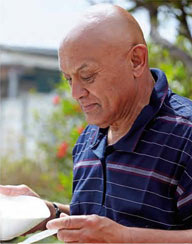
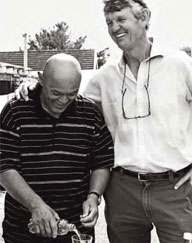
‘Food has always played a huge role in the Cape Malay community, but more so in the old days when it gave us a chance to sit around a table and talk about the issues of the day.
‘Because meals doubled as social gatherings, there was always lots of food around when we were growing up. In our street, neighbours would always be popping into the house and I distinctly remember one instance where koeksisters were passed over our fence.
‘Our parents might not have had lots of money, but the money that they did have was spent on good food, which in turn ensured good company. These days, that sense of community has largely disappeared and everyone gets on with their own lives.
‘Two meals I remember well as a child, and which epitomise our community, are denningvleis and malva pudding. My grandmother used to make denningvleis and my wife has perfected the recipe. There’s a lot of history attached to it and it’s probably one of the oldest dishes I can think of in Cape Malay cuisine.
‘It also shows the clear link between coloured communities and their Indonesian forebears, who used to make it with buffalo meat. The same goes for the very traditional malva pudding, which was adapted from the cookbooks of the early Dutch settlers.
‘The pudding was adopted by the Malay community through our forebears, who were slaves in the kitchens of the Dutch masters. These two dishes are obvious examples of how the history of a country and its people can be traced back through the food they eat.’

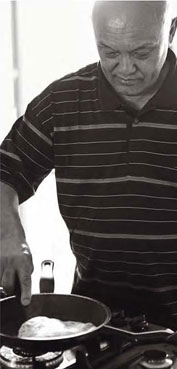
FORMER SARU NATIONAL TEAM EIGHTHMAN 1968, AND PRESIDENT OF PRIMROSE RUGBY CLUB
1 C (250 ml) sago
10 C (2.5 litres) milk
2 extra-large eggs, separated
¼ C (60 ml) water
¼ C (60 ml) custard powder
½ t (2.5 ml) salt
1 T (15 ml) butter
cinnamon sugar to taste
PETER’S METHOD:
‘Soak the sago in the milk for 1 hour. Gradually bring the milk and sago mixture to the boil over a moderate heat using a heavy-based saucepan. Stir frequently to prevent scorching and simmer until the sago is soft and transparent. Beat the egg yolks, water, custard powder and salt together. Add the custard mixture to the milk and sago and simmer until thick, stirring constantly. Add the butter. Beat the egg whites until stiff but not dry. Stir a little bit of the egg white into the sago mixture, then lightly fold the remaining egg white into the mixture, using a metal spoon. Pour the mixture into a serving dish and sprinkle generously with cinnamon sugar. Serve immediately.’
SERVES 10
PETER DE VILLIERS: Springbok coach 2008–2011, who led the team to their 2009 Tri-Nations and British & Irish Lions series triumphs
200 g butter, at room temperature
10 t (50 ml) castor sugar
1 T (15 ml) water
2 C (500 ml) cake flour
150 g whole nut chocolate
sifted icing sugar
GYSIE’S METHOD:
‘Preheat the oven to 180 °C. Line a baking tray with baking paper. Cream the butter and castor sugar. Add the water and then the flour and mix well to form a dough. Roll the dough into balls about the size of a walnut. Break the chocolate into blocks and halve each block. Press a piece of chocolate into each dough ball and then reform into a ball. Place the balls on the baking tray and bake for 15–20 minutes. Roll the balls in icing sugar while still warm. Allow to cool.’
MAKES ABOUT 40 BISCUITS
GYSIE PIENAAR: Springbok fullback 1980–1981, scorer of 59 points in 21 matches and father of Springbok scrumhalf Ruan
This cake is best eaten the day after baking.
1 C (250 ml) cake flour
5 T (75 ml) cornflour
1 t (5 ml) baking powder
¼ t (1 ml) salt
5 extra-large eggs, separated
1 C (250 ml) castor sugar
7 T (105 ml) iced water
CUSTARD FILLING:
2 C (500 ml) milk
5 T (75 ml) custard powder
¼ t (1 ml) salt
125 g butter, at room temperature
¾ C (180ml) castor sugar
1 t (5 ml) vanilla essence
biscuit crumbs for topping
BISMARCK’S METHOD:
‘Preheat the oven to 180 °C. Butter and line 2 x 20 cm cake pans. Sift the flour, cornflour, baking powder and salt together. In a separate bowl, beat the egg yolks and sugar until light and fluffy. Fold in the sifted dry ingredients together with the iced water. Using clean beaters, beat the egg whites until stiff and fold in. Pour the batter into the prepared pans and bake for 25–30 minutes. Allow to rest for 10 minutes before turning out. Place on a cooling rack and allow to cool completely.
‘To make the filling, heat 400 ml of the milk. Stir the custard powder into the remaining milk. Add the heated milk to the custard mixture, stir well, add the salt, then return to the saucepan and bring to the boil. Stir continuously and be careful not to let it burn. Remove from the heat and allow to cool. Beat the butter and sugar together until light and creamy. Add the vanilla. Beat in the cold custard mixture.
‘To assemble, cut each cake horizontally through the middle to form two layers. You will now have four layers. Divide the custard between the layers and the top layer and spread over. Sprinkle over the biscuit crumbs.’
BISMARCK DU PLESSIS: Springbok hooker 2007–2011, and 2007 Rugby World Cup winner
‘My brother Jannie and I might live in Durban now, but whenever we get some time off we’ll drive back to the family farm just outside Bethlehem in the Free State.
‘Whenever we go home, my mom, Jo-Helene, always makes rusks. I wish people could see the amount of rusks she makes! And whenever we’re about to leave she’ll give us this 25 kg box to take back with us. That’s a lot of rusks...
‘If we arrive on a Friday night, there’s always a lasagne waiting for us. Always. On a Saturday morning, we normally sit down to muffins, scones, mielie pap, egg, steak, chops and worsies. And you wonder why we play in the front row!
‘Everybody who knows the Du Plessis family knows that we virtually live in the kitchen. In the middle of it there’s this big cement table, almost oval in shape, and we spend 90 per cent of our time there.
‘On Saturday afternoons we have a bit of cold meat, but not much because we know that the braai that night is going to be serious. On a Sunday morning we’ll just eat some muesli, which my mom calls sondagpap, and in the afternoon Jannie and I always play what I believe is the biggest test match cricket in the world, outside on the grass. And afterwards we’ll either braai again, or roast a leg of lamb in the Weber, but not before Jannie and I have fought during the cricket.’
SPRINGBOK HOOKER 2007–2011, AND 2007 RUGBY WORLD CUP WINNER
2 C (500 ml) cake flour
2 t (10 ml) baking powder
1½ t (7.5 ml) bicarbonate of soda
1 t (5 ml) salt
1 t (5 ml) ground cinnamon
1½ C (375 ml) sugar
1½ C (375 ml) canola oil
4 extra-large eggs
2 C (500 ml) grated carrot (I often add a little more)
1 can (440 g) crushed pineapple (use juice and all)
2 pkts (100 g each) chopped pecan nuts (reserve½ C (125 ml) for the top of the finished cake)
ICING:
60 g butter, at room temperature
½ t (2.5 ml) vanilla essence
2 C (500 ml) icing sugar, sifted
½ tub (125 g) cream cheese
ANDRÉ’S METHOD:
‘Preheat the oven to 180 °C. Butter a 26 cm spring form tube pan. Sift the flour, baking powder, bicarbonate of soda, salt, cinnamon and sugar together. Mix the oil and eggs together and add to the dry ingredients. Stir in the carrot, pineapple and nuts. Pour the batter into the prepared pan. Bake for 45–60 minutes, or until a knife inserted into the centre comes out clean.
‘For the icing, cream the butter, add the vanilla, then gradually add the icing sugar until you get a dry, crumbly mixture. Add the cream cheese and fold in gently by hand, not with a beater, as it becomes very watery when overmixed. Ice the cake when completely cooled and sprinkle over the reserved chopped nuts.’
ANDRÉ VENTER: Springbok flanker 1996–2001, and scorer of nine tries in 66 Tests
‘My tips for the perfect cake are to use the same cup to measure the ingredients and to use eggs that are at room temperature and not straight out of the fridge. Also, make sure you use 2 x round 20 cm cake pans. Once the cake has cooled, each round must be cut in half horizontally through the middle so that there are four layers.’
1 C (250 ml) cake flour
2 T (30 ml) cocoa powder
2 t (10 ml) baking powder
1 C (250 ml) castor sugar
½ C (125 ml) canola oil
½ C (125 ml) boiling water
4 extra-large eggs, separated
1 t (5 ml) baking powder
ICING:
1 can (360 g) caramel condensed milk
3 T (45 ml) apricot jam
2 T (30 ml) desiccated coconut
4 C (4 x 250 ml) icing sugar
¼ C (60 ml) cocoa powder
250 g butter, at room temperature
2 t (10 ml) rum essence (optional)
about 5 T (75 ml) water
cherries and toasted flaked almonds for decorating
BRYAN’S METHOD:
‘Preheat the oven to 180 °C. Butter and line the cake pans. Sift the flour, cocoa, baking powder and castor sugar together into a bowl. Mix the oil and water together and add to the dry ingredients. Beat the egg yolks and add to the mixture, mixing in well. Using clean beaters, beat the egg whites together with the baking powder until stiff. Gently fold into the cake mixture. Divide the mixture between the two prepared pans. Bake for 20–25 minutes or until the cakes pull away from the sides of the pans. Turn out and allow to cool on a cooling rack before dividing into four layers.
‘For the icing, mix the caramel and apricot jam together. Divide the mixture in half and add coconut to one half. Sift the icing sugar and cocoa together. Cream the butter and gradually add the icing sugar mixture. Add the rum, if using, and the water and beat in, adding a little more water if it is too stiff.
‘To assemble the cake, place the bottom layer on a serving plate. Spread with a quarter of the icing sugar mixture. Place the second cake layer on top and spread with the caramel and coconut mixture. Place the third layer on top and spread with another quarter of the icing sugar. Place the last layer of cake on top and spread with the caramel and jam mixture. Ice the sides of the cake with the remaining icing sugar mixture. Decorate with cherries and toasted flaked almonds.’
BRYAN HABANA: Springbok wing 2004–2011, 2007 Rugby World Cup winner and the 2007 IRB world player of the year
